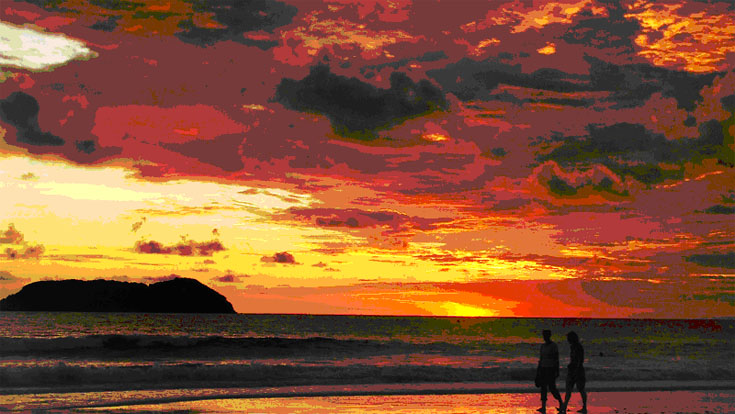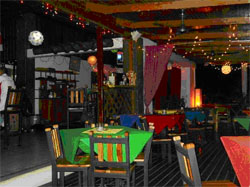|
|---|
Sunset As Seen from the Main Beach at Manuel Antonio |
Broken News
50th Anniversary
This edition marks the 50th anniversary issue of the Golden Gringo Chronicles.
 |
|---|
The Chronicles started in September of 2008 as a series of emails by our hero who sent them back to friends and family in the United States as "progress" reports on my relocation here.
The reports quickly grew into a monthly newsletter and became more detailed and sophisticated (I use that term liberally and technically in regard to the content, not critically). Gradually photos and videos were added and a web site developed as well as the standard format you see today. Edition archives and restaurant archives were added to make access to previous articles and information easier for both readers and the writer.
GG hopes you enjoy reading the Chronicles as much as I do writing them. Any suggestions you have on how to make them better or what other topics of interest might be included will be appreciated. Let me know what you think - email me at bob@bobnormand.com.
(Editor's Note: I wrote this piece with GG in the third person because the whole experience was surreal and I often felt like I was viewing the scene from a distance)
Earthquake scientists have been wagging their tongues for some time now saying we should expect a "big one" somewhere in the Nicoya peninsula. On September 5, 2012 it happened. The "terremoto" was centered near Samara on the west coast of the Nicoya, about 30 kilometers or 18 miles west of Puntarenas as the pelican flies and about 90 miles east of San José. The town of Puntarenas is also about 60 miles north of Quepos/Manuel Antonio where our hero lives.
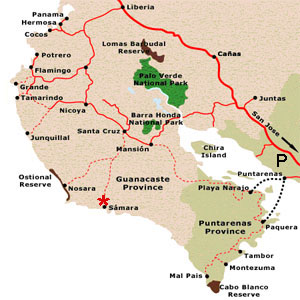 |
|---|
The Red Star Was the Epicenter, The "P" Is Puntarenas Where GG Was Visiting. Quepos is About 60 MIles South of P On the Coast |
The Golden Gringo picked the wrong day to go for an eye test at the Puntarenas hospital (also known as Hospital Monseñor Sanabria). It was GG's first visit to the town and it turned out to be one of the places most effected by this 7.6 Richter terremoto.
To put that number in perspective, 7.6 on the logarithmic Richter scale makes it more than 15 times as powerful as the 6.2 tremor experienced in Quepos in 2009 that seriously shook GG's apartment (see Shakin & Swimming). It's also good to remember that the Haiti earthquake that killed so many people was measured at 7.0 or 7.1 (see table below).
The latest earthquake hit about 15 minutes after GG arrived at the hospital, at 8:42 AM to be precise. GG had gone to a couple of windows to process his paperwork and, turning around, he spied a short bank of empty chairs bolted to the floor on one side of the waiting room. He headed for them.
GG was about three paces from his intended seat when the terremoto hit. The entire episode took only about 40 seconds to play out but it seemed like 40 minutes. The shaking built steadily for the first ten seconds, then violently crescendoed for the next twenty seconds then slowly petered out for the last ten seconds.
As the shaking peaked, a solid wave passed under the floor and catapulted GG sideways into the bank of chairs (no damage to GG or the chairs - our hero has a lot of padding). As he righted himself, he got a view through the waiting room window of bricks falling from the building facade and hitting the ground outside the main entrance. The screaming and terror among the people was intense (locals are more experienced at these things than I). The power went out and the emergency lighting came on. People began to rush out of the main entrance of the hospital to get away from the building. It was panic, pandemonium. Our hero was amazed at how many thoughts could race through his mind in a microsecond, much like what people report who have had a near-death experience.
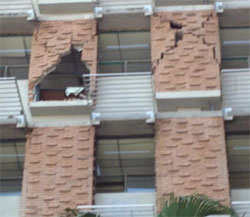 |
|---|
Facade on the Puntarenas Hospital After the Quake |
The reason why people were heading for the door finally registered in GG's mind. One should get away from being on the inside of the first floor of a ten-story building on the verge of collapse (duh). He went for the main door walking like a drunk man as the floor continued to move and heave. GG stopped at the door to look around and see if anyone needed help and also to see if the exit was in the path of the falling bricks. Suddenly, a security guard stiffly pushed him forward, "vayase" amigo, get the hell out of here!
Many people, including GG, ended up in the streets around the hospital in a bit of a daze wondering what the hell just happened. There didn't seem to be any obvious or serious injuries to the people milling around the vicinity of the hospital but workers were pushing emergency room patients, complete with IV's dangling, across the main street to get away from the building
The phone systems were either overloaded or damaged as all cell phone traffic was dead and stayed that way for a couple of hours. The road in front of the hospital was soon blockaded by the police and the traffic rerouted around the hospital area.
After about thirty minutes, and since there didn't seem to be anything GG could do to help, and the eye exam was obviously not going to happen that day, he began to think he'd call it a day. He thought of walking down to Puntarenas beach which he had never seen, perhaps have some lunch and catch whatever afternoon bus later presented itself bound for Quepos. It was about this time that word started to spread through the crowd that a tsunami warning had been issued. On verifying that report, GG changed his plan and decided to walk inland and away from the beach as did many other people. The crowd had to walk a quarter mile or so to the main highway (autopista) to find transportation.
At the highway there were crowds of people hailing taxis and overloading buses as folks sought any way they could to get out of Puntarenas. The traffic was heavy to the south and GG thought for the first time since moving to Costa Rica four years ago that this was one situation where it might be nice to have a personal car. While waiting, he noticed that all the land going inland from the hospital was lower than the beach area. He began to scan the palm trees for the largest and strongest trunk that might withstand a tsunami wave. The houses and stores, even on the roof, would offer little help considering they were all one story. Without cell phone capability people didn't learn until much later that the tsunami warning had been lifted shortly after it had been issued.
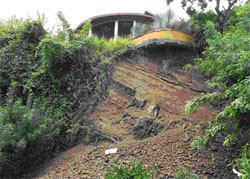 |
|---|
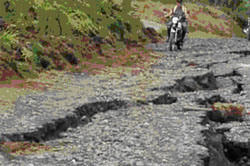 |
 |
Some Shots of Damage Done: Top - A Shore House Near Samara; Center - A Road in the Nicoya; Bottom: A Shore Point That Slid Into the Sea in the Southern Nicoya |
Up to this point, all this had occurred in a relatively short period of time, but Quepos-bound people had to wait on the side of the highway until almost 10 o'clock for the scheduled 9 AM bus to show up. That bus too became strongly overloaded and our hero wasn't looking forward to standing in the aisle for three hours all the way to Quepos but by the time the bus got half way to Jacó, many of the people had gotten off. Then two teenage Tico boys gave up their seat to a lady and the gray-haired GG. Muchas gracias, amigos. The boys got off near Jacó.
Damage from the quake was reported all over Costa Rica but most of it was superficial like goods falling off shelves in stores (see video below). There was, however, some significant damage to roads and buildings the closer you got to the epicenter (see photos left). A railroad bridge and a couple of pedestrian bridges collapsed into rivers.
Another report stated that the entire peninsula of Nicoya had risen one meter (that's over 3 feet!). Some beaches found themselves wider and deeper than ever before. Other beaches were severed by long cracks much like what occurred on some of the roads.
The day after the quake it was announced that Puntarenas hospital would be out of commission for a least a week for safety evaluation and there were strong suspicions that the top floor would not be usable for a long time. A number of other hospitals in different regions ranging from San José to the east coast near Limón reported damage.
Two deaths, a lady who suffered a heart attack and succumbed and a construction worker who was killed when a wall collapsed on him, were initially reported to be quake related but later pronounced by the President of Costa Rica as unrelated to the tremor. Evidently the wall collapsed on the construction worker a couple of hours before the quake.
To be trite, the fact that there were not more injuries and deaths was a veritable miracle. Compare the intensity and casualties of this latest earthquake with some others of import:
| Location | Year | Fatalities | Richter | Depth |
|---|---|---|---|---|
| Cartago, C.R. | 1910 |
700 |
6.4 |
? |
| Limón, C.R. | 1991 |
47 |
7.7 |
10 km |
| 30 km N of San José | 2009 |
40 |
6.1 |
5 km |
| Port au Prince, Haiti | 2010 | 222,500 |
7.0 |
13 km |
| Nicoya, C.R. | 2012 |
0 |
7.6 |
41 km |
As you can see, the Richter scale is only one indicator of the power of these phenomena. The intensity with which one feels the quake and by which it causes damage depends on 1) the strength of the quake (Richter Value) at the epicenter, 2) the depth and proximity to inhabited areas; the closer and shallower the epicenter, the more likely it is to cause higher damage and 3) the type of construction used in the area. In this latter regard, Costa Rica had abandoned the adobe style of construction decades ago, a style which has been attributed to many deaths around the world during events like this.
Surveillance Camera Captures Quake in a Retail Store in Nicoya |
The major cause of the 700 fatalities in the earthquake at Cartago, Costa Rica in 1910 (Richter 6.4) was attributed to the widespread use of adobe construction in that city. The Haiti disaster two years ago had everything bad going for it; the epicenter was within 25 km (15 miles) of the capital city, was shallow and much of the construction was squalid slum adobe type. The net result: almost a quarter of a million deaths.
So what may have saved our collective Tico butts was that, even though this terremoto was virtually tied for the strongest in the country's history, our quake was deep, relatively remote (compared to the highly populated central valley for example) and construction practices have improved significantly including hospital structures. There were a few buildings around the country damaged beyond repair and the bridges previously mentioned will need to be replaced but in retrospect the damage was relatively light, as were the casualties.
About one week after the tremor, the Observatorio Vulcanológico y Sismológico de Costa Rica issued a report stating that the 7.6 quake September 5 was "...expected, but that another quake at the same or greater magnitude is likely". The Observatorio ":...estimates that the fault which generated the quake has expended 50 percent of its energy but that the joint (between the two tectonic plates - Ed.) only slipped 1.85 meters (6.1 ft) of a possible 4 meters (13.2 ft)." So, stay tuned amigos for further developments.
Two weeks after the quake, the government announced it is highly likely that the hospital will have to remain abandoned indefinitely and may need to be razed. Coincidentally, the health system had acquired a 12 hectare (30 acre) plot in the Fray Casiano district, an area contiguous to Puntarenas. Plans are now in process ("en tramite") to design and build a new Hospital Monseñor Sanabria on this site, however that can take years. In the meantime, our hero has learned that ophthalmologic services have been transferred to nearby Casa de Monjas (house of nuns). GG has not been in a nunnery since taking piano lessons in the parish convent in grade school. So another Tico adventure enfolds for the golden one.
On September 5th, about five hours after the terremoto, our hero got back to Quepos unscathed, grateful and anxious to tell his story to anyone that would listen.
Life is good amigos, we need to appreciate it.
¡Pura Vida!
Mo' Money Matters
Back in August of 2011, the Chronicles reported on the changes in certain coins and bills in the Costa Rican money system (see MONEY).
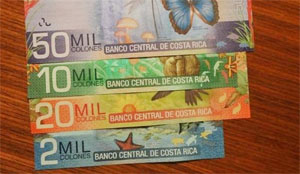 |
|---|
New 10, 20 and 50 Thousand Colone Notes |
We also reported that more changes would be forthcoming to Costa Rican bills, namely the five and ten thousand colone bills and also that a new 50,000 colone bill would be added. The banks began to circulate the new bills on Monday, August 27. The new notes are pictured to the left (note that the width of the bill is slightly larger as you go up in denominations).
The new bills hadn't been out two weeks when counterfeit bills began to turn up. An interesting thing about these bills was pointed out to me by a store clerk. She took a crisp new 10,000 colone note and inverted it, bringing together the two ends of the backside of the bill. If the flowers on both ends match up perfectly, the bill is probably real. Evidently this is difficult to reproduce in a counterfeit, but I'm not sure why.
Tip: If you visit here, make sure you use or otherwise rid yourself of the old 5,000 and 10,000 denomination bills, do not hold them for your next trip.
The last time a change like this happened, with the one thousand and two thousand notes, the Central Bank here gave people 60 days to convert their old money to new at a national bank such as Banco Nacional or Banco de Costa Rica. Then they gave an additional thirty days to convert them but only at the Central Bank of Costa Rica in San José. After that period old notes were useless and not accepted by either merchants nor banks, including the Central Bank. Good for souvenirs only amigos.
This time the government is being a bit more generous. You will be able to use both old and new bills until December 31. From January 1 to April 30 of 2013 you will be able to convert the old bills only at commercial banks and after April 30 only at the Central Bank in San José. The point at which the old bills will not be accepted anywhere, even at the Central Bank, has not been announced.
Because of the larger denominations there is more at risk by holding old notes this time, so be aware amigos.
Easy Panama Residency
For those of you that followed our hero's effort to gain official residency in Costa Rica over the last two years (see Cédula, Gullible Travels, Cédula Update), you may remember the complicated and rather frustrating procedures I had to go through (with the further complication of a rather unscrupulous attorney) to obtain the little document that looks like a credit card ..
Now, a recent press report about our neighbor to the south recently was phrased like this: "Panama Allows 'Immediate Permanent Residence Visa' for 22 Countries". The new policy is available to people of four English speaking countries, i.e., the United States, Canada, Great Britain and Australia. The government's objective is to encourage potential expats to consider Panama as a retirement and investment location and the policy aims to make that simple for foreigners to do.
 |
|---|
Leaky Julian Assange |
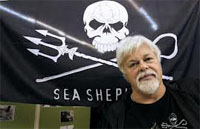 |
Pirate Paul Watson What Nerve Putting Your Picture on Your Own Flag |
The primary requirement for the new residency category is a valid passport and clean police record. If you're not a Julian Assange (Wikileaks snitch) or a Paul Watson (Sea Sheppard commander, fish net cutter and fugitive from Costa Rica), and you don't have an outstanding felony in your home country or a check mark on your Interpol record, you could receive residency in a matter of days rather than months or years.
But there are some requirements. You must deposit $5,000 in a local bank plus $2,000 for each dependant residing with you. There was no information as to whether or not that money was to be escrowed or you could immediately begin using it again (my guess us it's escrowed). Obviously, a family of four means a cash deposit of $11,000, not that easy for some people.
In addition "Applicants will also have to show evidence of one of the following: an investment in real estate in Panama (I presume owning a house there covers this requirement), ownership of a Panamanian corporation with a business license, or an employment letter and contract from a business in Panama".
People living in Panama that your humble reporter has talked to say getting a pensionado (retired dude) residency there is a matter of two to three months, as opposed to six to eighteen months in Ticoland. Cost of doing so is probably significantly less also, as are many things south of our border.
Mind you, I'm not suggesting or recommending one country over another, just reporting the facts. I love Costa Rica and the few times I've visited Panama I've found it dryer, hotter, less green and with no better beaches (I have to qualify this by suaing that I speak only of the west coast and the only beaches I've seen are in the north Pacific coast).
As my old Latin teacher, Sister Domitilla (nicknamed 'Domitilla the Hun) used to say: "Degustibus non Disputandem Est' or 'There is no disputing taste'. And given the girth she displayed, she should know (mea culpa, mea culpa, mea maxima culpa sister)
GGC Poll Results
In the email for the last edition GG requested input as to our Gentle Readers' preference for the length of the newsletter. The results are:

With such encouragement and 78% saying the length is about right or even could be longer I feel encouraged to keep writing unencumbered by concerns about length. For those of you that want a shorter version, please remember that a summary of the content of articles appears at the top of each Chronicle ("In This Issue") along with a navigation bar ("Links/Shortcuts") that will take you to individual articles and sections.
Of course the dudes that put me into the "Twit" category were my closest friends - so what do they know that the others don't?
Hurricanes, No Gracias
(Why Hurricanes Never Hit Costa Rica)
Unlike my previous home in Florida, we don't worry about hurricanes hitting here, at least not full force hurricanes.
We're subject to earthquakes as reported above and tropical storms but horrendous hurricanes hardly ever happen in happyland, as Eliza Doolittle would say. We do see some serious rain and wind effects from tropical storms, usually coming off the Pacific. 2010 was particularly bad - see (Tormenta , Anatomy of a Landslide). Or perhaps we feel the effects of a would-be-hurricane developing as it passes in the vicinity of the east coast, but we never get the brunt of a full force hurricane in Tiquicia. Why is that?
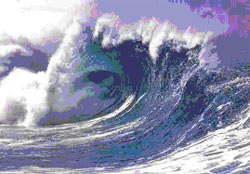 |
|---|
Surf's Up - Let's Go Swimming |
GG is not a stranger to hurricanes. During the 1950's some 16 hurricanes hit or nearly hit the island and beach community north of Boston where I grew up. I can remember several summer homes and permanent residencies being undermined, dragged out to sea and crushed like match sticks by waves that were 30 to 40 feet high. That's not an exaggeration, I saw them and other observers report heights over 60 feet in various parts of the world. If you get caught in such a wave and slapped to the ground as it crashes you can easily die.
I remember nearly drowning once when I was a young teenager, a time when most kids think themselves indestructible. I and several of my buddies thought it would be cool to swim in the 15 foot waves the sea was still producing one day after a major hurricane had hit. Thanks to an alert life guard, I was prevented from going out to sea in the strong backwash which I couldn't overcome. The guard dove in, grabbed me and came walking out of the surf with me dangling under his arm like a surfboard, much to the delight of my buds - oh the embarrassment of it all. But I must say that since then I've had a very healthy respect for large bodies of water, especially when they're moving.
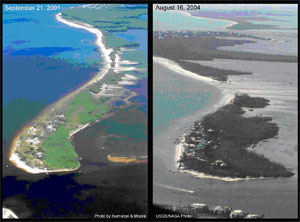 |
|---|
Captiva Island Near Fort Myers Before (Left) and After Charley (Right) |
Florida is known as a very active hurricane state, although I hurry to add that in the 10 years I lived there (1998 - 2008), we never experienced a direct hit on Sarasota despite over 30 hurricanes hitting the state during that period. Some people said the last major one to hit the city was in 1978.
The most active year in Florida that I remember was 2004 when the state was treated to four major storms of hurricane strength: Charley, Frances, Ivan, and Jeanne. Charley was a Cat 5 but very tight and narrow. It went onshore at Port Charlotte about 50 miles south of Sarasota, headed north through Arcadia and then through Lakeland, eventually blowing itself out over land. In the process it cut Captiva Island in two (see pictures right).
The funny thing was that people who moved inland from Sarasota to Arcadia and took shelter in a large auditorium to avoid the storm were treated to their roof being torn off while Sarasota received only light breezes (maybe ironic is a better word than funny).
Frances came ashore at West Palm Beach and then northwest through Lakeland (poor Lakeland - 2004 was not a good year). Ivan stayed off the west coast beyond serious damage range until it plowed into the panhandle. Jeanne was weird, running up the west coast of Florida like Ivan, cutting across the northern region, entering the Atlantic where it reinforced itself. It then turned 180 degrees (!) and went back across Florida eventually turning up the east coast inland as a rain storm. Never saw a hurricane so fickle and act like that.
Meteorologists tell us that large, swirling storms require warm water (in Costa Rica we have plenty of that at all times of the year) but that the cyclones almost never form below 10 degrees north latitude and Costa Rica is just 9 degrees above the equator. Meteorologists and other scientists attribute the formation of hurricanes to something called the Coriolis Effect. Without getting into advanced fluid dynamics principles (as if I could), one might visualize a relatively flat surface turning at 1,000 miles per hour (the earth) and an updraft of air, perpendicular to the surface fed by heated air from warm water (Atlantic and Caribbean in the summer). As the updraft is fed by the heated air, it grows and the frictional pull of the rotating earth causes it to spiral and the funnel to grow and spin faster and faster.
So, why not in Costa Rica? It's because the Coriolis Effect is weakest at the equator where air spinning is minimal. It increases as distance from the equator increases but doesn't reach critical strength for vortex formation until above 10 degrees latitude.
I guess we'll have to be satisfied here with our terremotos (earthquakes).
They're Cuckoo for Cocos Cache
(One More Try to Find Costa Rica's Hidden Treasure)
In September of 2011, the Chronicles featured a few Costa Rican legends that have been told here for centuries. Among these was the Lost Treasure of Cocos Island, a story of 19th century pirates and misplaced Spanish gold that has a basis in fact. The Cocos Islands are located about 550 km (340 miles) off the Pacific Coast of Costa Rica and the area is a Tico National Park.
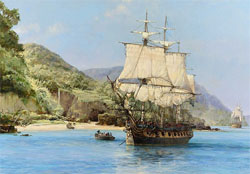 |
|---|
Artist's Rendition of Captain Thompson's Ship 'Mary Dear' |
The story goes that in 1820 the Spanish empire in the new world and based in Lima, Peru was threatened by a rebellion . Now the governing señores, town jefes and sacerdotes (priests) of the Lima protectorate had been pack-ratting treasure for over 200 years in the form of religious articles like solid gold, life-sized statues of saints and many jewels (they were much better savers back then than the present day Spanish).
Fearing they'd lose their goodies, the poders-to-be decided they needed to haul the stuff off somewhere and so they hired an English swashbuckler named William Thompson and his ship, the Mary Dear (only Billy knows how Mary got involved in all this). Now Latinos and Brits didn't mix well during that period as Spain and England had engaged in at least four major wars in the previous 200 hundred years, some of which lasted 20 years. So the Lima dudes must have been really hard up for a boat if they hired the Brit adventurer Thompson.
But Bill was a pirate at heart and convinced his crew it would be cool to steal the treasure; so they did. Later, after a spirited chase by the Spanish navy, Thompson and his crew were caught and returned to Lima where all the crew except Bill and his first mate were hanged (I wonder if they read them their rights).
Bill got himself and his mate off by promising to lead the Spanish to the Treasure on Cocos Island. When they arrived back at the island, Bill and the mate escaped into the jungle and were never seen again. Is the cache really there or might it have been buried on another island? The question has intrigued treasure hunters for almost 200 years.
So what's all the fuss about a few trinkets? Well, here's what researchers think is in the cache:
- 113 solid gold religious statues
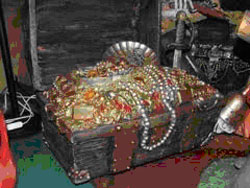 Two Hundred Chests Like This?
Two Hundred Chests Like This? - 200 chests of assorted jewels
- 273 swords with jeweled hilts
- solid gold crowns
- 150 chalices (often gold and bejeweled)
- hundreds of gold and silver bars
Total value today is expected to be in excess of $250 million.
Many famous and not so famous explorers and adventurers have sought the lost treasure but to no avail. They included Franklin Delano Roosevelt before he became President, actor Errol Flynn and racing car driver Sir Malcolm Campbell. Also, German explorer August Gissler, appointed by the Costa Rican government in 1789 as governor of the island spent nearly two decides trying to find the treasure. He returned home with just six gold coins (bummer, Auggie).
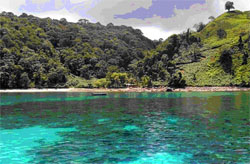 |
|---|
A Landing Spot on Cocos Island Did Thompson Go Ashore Here? |
But now, a new team is going to try again, headed by a British engineer named Shaun Whithead. Engineers always like tech stuff and Shaun happens to own a company that makes state of the art specialized electronic sound detection equipment. He intends to use this equipment to find buried metals, hidden caves and the treasure.
Of course the Costa Rican government is Cocos Island's owner and therefore the owner of the treasure, so the head Ticos say. Whitehead had to agree to that little detail and be content with expecting only reimbursement for salvage expenses, whilst the rest becomes a national treasure.
The expenses could be considerable considering Whitehead has a team of 15 persons, several boats and a helicopter plus the cost of his own equipment). Hopefully, he will get his reward through TV and movie contracts and selling his famous equipment should he succeed in finding the treasure. The goodies, if found, will go to Costa Rican museums (they'll have to seriously expand the current museum or build a new one if all those items mentioned above are found.).
Of course, we should expect that Peru will also be anxious to get legally involved if the treasure is found since they were the original owners of the trinkets.
Aye, matey, find the damn stuff, it's time!
Rubber Duckies
(Not Just in My Bathtub Anymore)
If you didn't have a rubber duckie as a child, you're probably in rehab or some form of treatment by now.
.jpg) |
|---|
GG and His First Rubber Duckie (If You Buy That, I Have Some Waterfront Property in Florida You Might Be Interested in) |
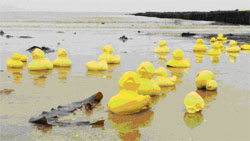 |
Rubber Duckies Washing Up |
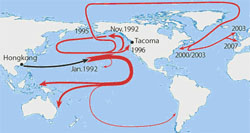 |
Where the "Friendly Floatees Have Traveled So Far |
One of the first mysteries in life that must be overcome is why some things float while other things, like me, sink. With this awareness, I developed a spiritual connection with my own plastic canard during my infancy. This set into motion a certain admiration for rubber duckies that has never waned and an expectation that the world would someday realize that they're more than just a little toy..
Now comes word of a very interesting phenomenon. A freighter that left Hong Kong in 1992 bound for Tacoma, Washington encountered a severe storm at sea and lost a container overboard that contained 28,000 rubber duckies (I don't think my rubber duckie was Chinese; I believe, back then, it was made in America). The container broke open and the happy duckies all escaped into the sea. Since then, the little guys have been turning up on beaches and in bays all around the world.
Some have washed up on the shores of Hawaii, Alaska, South America, Australia and the Pacific Northwest; others have been found frozen in Arctic ice. Still others have somehow made their way as far as Scotland and Newfoundland in the Atlantic. Some of them have traveled over 17,000 miles.
What's significant about this is that these little fellas, who some have christened the "Friendly Floatees", have taught us more about ocean currents in the last twenty years than all the studies before. Planned studies have involved releasing 600 to1,000 tagged bottles and waiting for the less than 2% recovery rate that is typical with flotsam. Obviously, releasing the larger numbers of rubber duckies presents a greater possibility of recovery and therefore we learn more.
The little duckies have wound their way around the world to virtually every continent (see map left). When they entered the Bering Straits, they were frozen into the ice flows, eventually emerging in the warmer Atlantic east of the Canadian/U.S. border where they melted, passed over the Titanic and deposited themselves on northern European shores. They have also been reported in South America (Chile) and as far away as Australia.
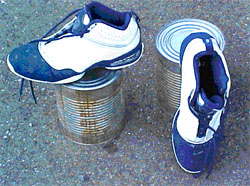 |
|---|
Free Nikes and Cans of Chow Mien |
The good news is that the duckies have more precisely determined the movement of the so-called Northern Pacific Gyre (G-eye-er) which is also shown on the map above as a flattened oval just west of Canada. The bad news is that the rubber duckies simply add to the already extensive flotsam caught there by the circular current.
The amount of the waste in the gyre spiral is augmented by the hundreds of shipping containers that inadvertently go overboard each year. Among the stuff that went overboard in recent years was a container of 33,000 Nike shoes and a container of dried chow mien noodles in cans. Both have been recently found washing up on the Pacific Northwest shoreline.
The interesting thing about the Nikes is that they were recovered in good shape, almost as good as when they went overboard. Unfortunately they are not showing up in matched pairs so if you find the right shoe, size 10, you may have to wait a while for a size 10-left to show up. The noodles, on the other hand, are ready to eat according to people who have tested them.
So, if you see GG running on Manuel Antonio beach in new bright-blue Nikes munching dried chow mien noodles, you know what happened.
What's-in-a-Word
Tricky Translations
If you've ever studied a second language you know that it is often difficult to translate from one to another verbatim. A thought in one language often has to be expressed in a different way in another language.
Likewise, some words in one language just shouldn't be used in another, to wit:
-
Chevrolet introduced a model called the Chevy Nova in the sixties (my future ex-wife bought one of the earlier versions). I was fond of telling people that the "stick" shift on the Nova had the same sticking problem in second gear as my Dad's 1953 Chevy (some things, like GM engineering, never change).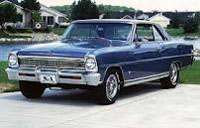 1966 Chevy "No - va"
1966 Chevy "No - va"
The problem was, that when Chevy tried to market the Nova in Latin American countries where the auto execs were apparently unaware that "no va" in Spanish means "It doesn't go". Chevy had to rename the model for those markets and they called it the "Caribe".
-
When I worked for a major chemical company, we got a new president at one point who had been an executive vice president for Exxon (originally, Standard Oil of New Jersey). Exxon was originally marketed under the Esso brand name. The new president (who often referred to Exxon as "double cross oil" - guess he didn't get the job he wanted there) loved to tell the story of the time when they came up with the Exxon name. They later discovered the name meant something very nasty about your mother in Japanese and wasn't too attractive in a couple of other languages also. The Original Standard Oil Logo
The Original Standard Oil Logo
Exxon decided to keep the Esso trademark but only for international operations. l have no idea what they've done, if anything, since they merged with Mobil Oil - maybe it's now Esso-Mobile or Mobilesso (I like that last one, it sounds rather Italian, don't ya think)?
And then there are the outright translation bloopers:
- When Parker Pen marketed a ball-point pen in Mexico, its ads were supposed to say "It won't leak in your pocket and embarrass you". However, the company mistakenly thought the Spanish word "embarazar" meant embarrass when actually it means "pregnant". So the ads actually read "It won't leak in your pocket and make you pregnant"
. - An American T-shirt maker in Miami printed shirts for the Spanish market which promoted the Pope's visit. Instead of the desired "I Saw the Pope" (in Spanish: Yo Vi El Papa), they said Yo Vi Papas or "I saw the potatoes".
-
Chicken-man Frank Perdue's slogan, "It takes a tough man to make a tender chicken", got terribly mangled in another Spanish translation. A photo of Perdue with one of his birds appeared on billboards all over Mexico with a caption that explained "It takes a hard man to make a chicken aroused". Me Good Translator
Me Good Translator
- An Acapulco hotel sign read "The manager has personally passed all the water served here"
- Moscow hotel brochure - "You are welcome to visit the cemetery where famous Russian and Soviet composers, artists and writers are buried daily except Thursday"
- At a Bangkok dry cleaners - "Drop your trousers here for best results"
- Hong Kong advert - "Teeth extracted by the latest methodists"
- Tokyo shop - "Our nylons cost more than common but they are better for the long run "
Languages are fun but it's prudent to be careful in how you use them.
¡Pura Vida!
ROMEO Corner
(Retired Old Men Eating Out)
Salsipuedes
Location: Top of Manuel Antonio Hill Across the Street from BCR and Promerica Banks
Hours: 7 AM - 10 PM Most Months with Breakfast, Lunch, Dinner Wednesday to Monday, Closed
Tuesdays. During the Low Season, Breakfast Becomes a Brunch Served at 10 AM.
Parking: Ample on the Restaurant Lot
Contact: Tel.: 2777-5019; Fax: 2777-5019; Email: N/A; Web: N/A
Reviewing ROMEOS: Beth M., Jim M., John S., Bob N.
To Review Our Rating System and Procedure, go here: R.O.M.E.O. Rating System
This is another well known Manuel Antonio restaurant with a view to the Pacific, which means it's gorgeous for breakfast and lunch, but you need to be there before 6 PM for dinner if you want to see the sunset.
This dining room suffered a major crack during a 2004 earthquake but weathered the latest one much better. The room is open-air and overlooks the jungle that recedes below into the ocean. In the evening this results in a very nice temperature for dining. Like many eating spots here, the dining room utilizes much of the rich wood that |
 |
||
|---|---|---|---|
$$$$ |
|||
is prevalent in this area. This includes the perennial wood chairs without padding that do little for GG's back. The room is gently lit with indirect lighting and some string lights as well as small candles on the tables. The tables have colorful table cloths. The place is not fancy, just pleasant.
The menu was attached to something that looked like a cutting board with a handle which made them a bit cumbersome. They're also printed with a black background that makes reading in the dim light a bit difficult (GG realizes that things like the hard chairs and small print on menus are picayune criticisms by an old dude but probably of no consequence to or even noticed by a younger person).
There were only three tables in service while we were there. We dined early, 6 PM. This is the slow season in Manuel Antonio with September being the slowest month of the year, so we were lucky to be served by the wife of the owner, Marcela. She is an Argentine, from the Buenos Aires area, a good cook and gives her food interesting little Argentine twists.
We ordered some onion rings and fried calamari to start. Both the onion rings and the calamari were cooked in a very light, almost delicate batter. For some reason, all four ROMEOS chose the same entree; a dish billed as curried chicken. The sauce used on the chicken breast filets was more like a slightly spiced tomato sauce or perhaps it was a red curry; either way it was very tasty. It was served with a Japanese rice (flavored and stickier than normal) and steamed vegetables that had been brushed with an interesting mixture that included limone. Some of us had desert and a favorite was grilled pineapple with some vanilla ice cream in the middle and doused with chocolate sauce.
By consensus, the ROMEOS give Salsipuedes four sloths for atmosphere, food quality and service.
For three courses (calamari, chicken curry, pineapple desert) and a couple of soft drinks, the check for one person came to about $30 including the compulsory 23% sales tax and service charges. This puts the restaurant at about a 4$ rating or in the top 20% expense level in this area,quite fair for the food provided..
Overall, Salsipuedes represents a pleasant dining option for this area.
Founder's Quotes
"And can the liberties of a nation be thought secure when we have removed their only firm basis, a conviction in the minds of the people that these liberties are the gift of God? That they are not to be violated but with his wrath? Indeed I tremble for my country when I reflect that God is just: that his justice cannot sleep for ever." --Thomas Jefferson, Notes on the State of Virginia, Query 18, 1781
(and Tom belonged to no major religion, he was a Deist)
don Beto de Quepos, El Gringo Dorado Pura Vida! |
To Contact GGC World Wide Headquarters (yuk, yuk) to request addition or deletion from the Golden Gringo Chronicles distribution, make comments, suggest topics or criticize my bad jokes, just send an email to: bob@bobnormand.com. Be pithy but kind. I'm sensitive. |
|---|

